“Competitive Mateship” The Key To Australia Re-Setting Its Olympic Open Water Selection Process
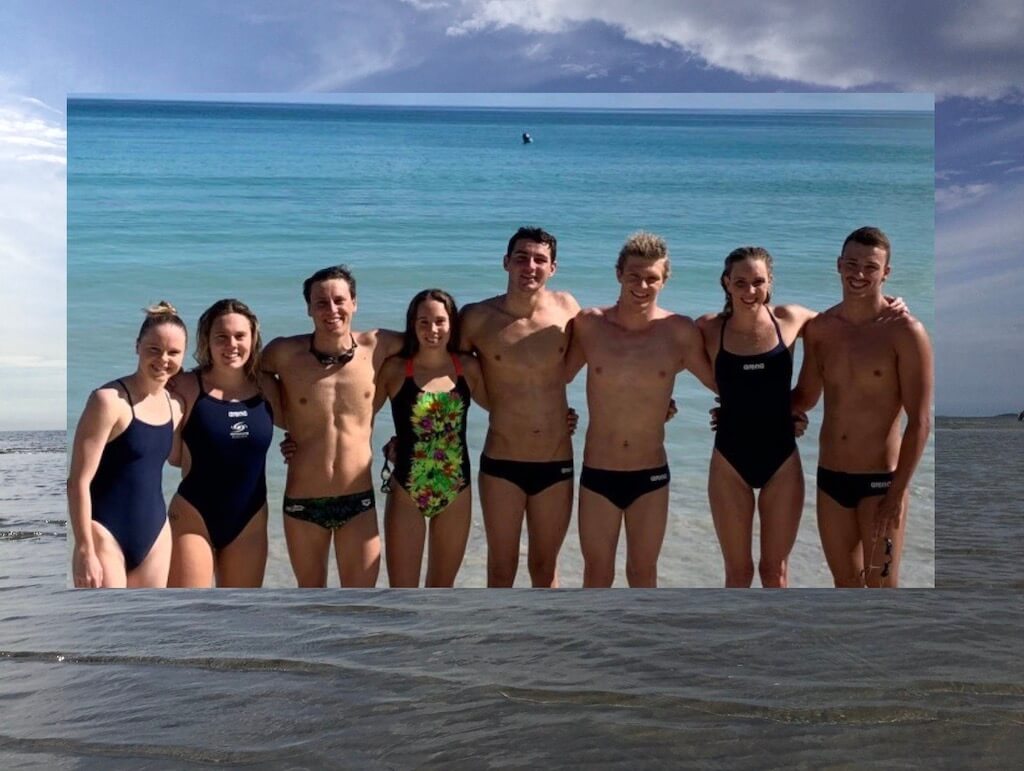
Making an Olympic team was never meant to be easy but whoever pulls on the green and gold blazer as Australia’s lone male open water swimmer in Tokyo next year will certainly have one helluva journey to talk about.
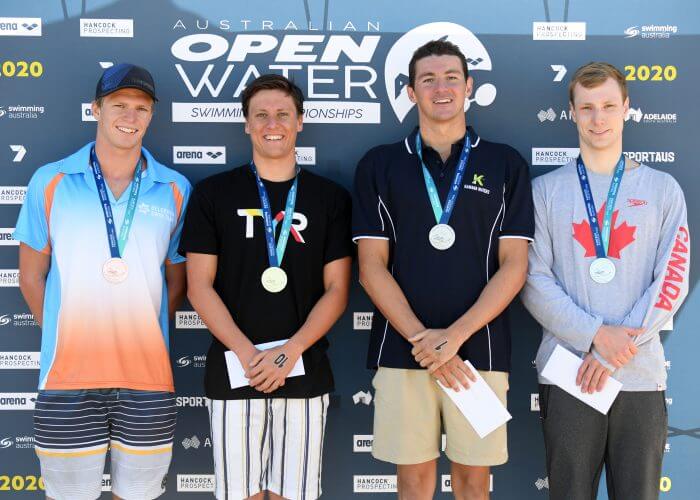
MATESHIP: Three of the four amigos (L-R) Hayden Cotter, Nick Sloman and Bailey Armstrong with Jon Mackay (Canada) at this year’s Australian Championships. Photo Courtesy: Delly Carr, Swimming Australia.
So far it’s a story about four young Queensland boys – Nick Sloman (Noosa Heads), Hayden Cotter (Belgravia, Burpengary), Kai Edwards (TSS Aquatic, Gold Coast) and Bailey Armstrong (Kawana Waters) – all with their sights set on that exclusive Olympians club.
And as the marathon process towards Tokyo unfolds, Swimming Australia’s Open Water Performance Manager Greg Shaw, is fostering a philosophy of “competitive mateship” amongst his coaches and his swimmers.
Something that has grown out of isolation as arch rivals in competition start to train together with their sights set on producing that one special Olympic performance.
It will be a story made up of so much more than all the thousands of kilometres these boys have already churned through to get this far and the thousands more they will clock up before July next year.
Today in Fukuoka two of those boys, Cotter and Armstrong should be on the start line – preparing for a final 10km selection swim around Seaside Momochi Beach Park in the now postponed Olympic Marathon Qualifying Race.
But for now the dream of that Olympic blazer fitting is very much on hold.
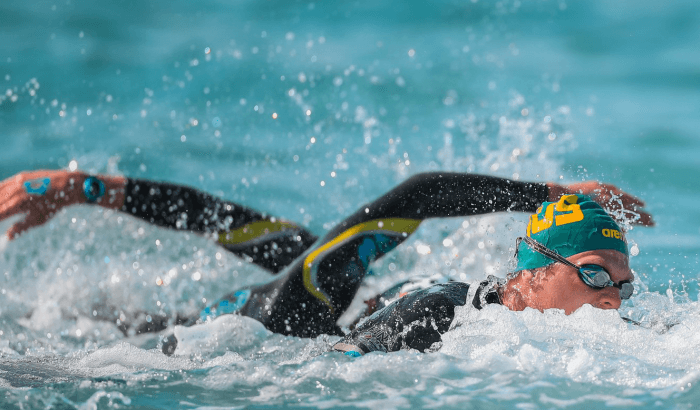
HEAD ABOVE WATER: Australia’s Hayden Cotter with his sights on Tokyo. Photo Courtesy: Doha Swimming Association.
“Kid” Cotter, at 19, the youngest of the foursome and a three-time Lorne Pier to Pub winner with victories over Rio Olympic champions Mack Horton and Gregorio Paltrinieri.
Who produced the swim of his life in Doha to qualify for Fukuoka – finishing seventh and beating home another Rio Olympic champion in 10km gold medallist, Dutchman Ferry Weertman.
WELCOME BACK COTTER AS ARMSTRONG SHOOTS FOR THE MOON
And joined by never-say-die champion Northcliffe lifesaver Armstrong, over the moon just to be on that start line in Japan, after landing his place in a frantic and controversial qualifying finish in Doha by just 0.1secs.
But alas – due to the postponement of Tokyo 2020 to 2021, Fina announced this week that the same qualifying race has now been re-scheduled for May 29 and 30, 2021 next year – with the qualification process stopped and declared null ‘n void.
For Cotter and Armstrong it’s back to square one with the race for selection starting all over again and open to all-comers – the revised events in the planning hands of Swimming Australia (SA).
“The boys have all accepted the situation and the challenges really well..each of them individually and each of them completely differently…it’s been encouraging to see them maintain some fire in the belly; it has been really exciting to see where they’re at and what they are planning on doing,” said Shaw.
After consultation with Shaw and his High Performance team; the Open Water Technical group and the National Events team, SA will next week announce its revamped Olympic selection criteria.
Because of these uncertain times it will be far from set in stone but at least for the athletes and their coaches it will throw some light on the next chapter towards qualification.
But Swimming World can reveal that the process will start with the Australian Championships in January and in a perfect world also include a Fina World Series race again in Doha to determine the two starters for Fukuoka.
But it could well just come down to the Australian Championships.
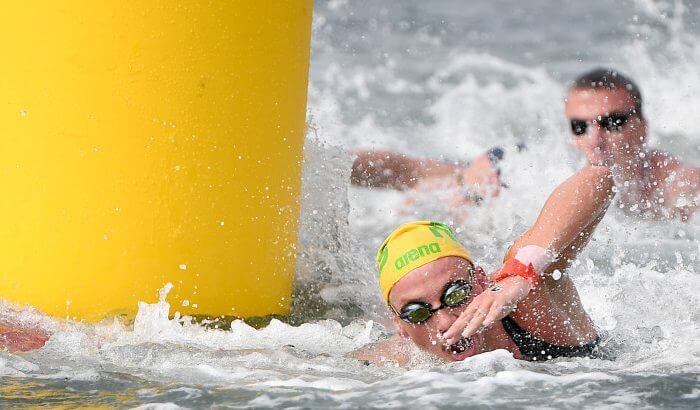
BUOYED BY ANOTHER CHANCE: Kai Edwards in the 25km World Championships in Korea. Photo Courtesy: Delly Carr, Swimming Australia.
And waiting to re-join the selection fray will be Sloman, the reigning and three-time Australian 10km champion and Pan Pac bronze medallist from 2018, who was surprisingly swamped in Doha, finishing 25th and rising Gold Coast star Edwards, the boy Armstrong actually beat by the 0.1 margin in that controversial Doha finish – a result maintained after various video submissions.
Edwards coach Chris Nesbit had revealed after this year’s Australian Championships that his young charge had been hospitalised with an energy-sapping virus just days before the race.
And up until the morning of the 10km selection event for Doha he was very much in doubt, but despite producing one of the most extraordinary performances Nesbit had ever seen, he finishing out of contention.
Armstrong’s coach Michael Sage had also revealed that his charge, who “blew up” after just seven kilometres, had also been struck down by a mystery virus.
Both boys missed automatic selection on the Australian team and were forced to fund themselves to the Doha race – backing themselves in the race for that one remaining Olympic berth.
And after missing Fukuoka, a shattered Sloman, who had the runs on the board, had now set his sights on making the Olympic pool team in the 1500m freestyle after an encouraging time of 15:05 at the Queensland State Championships earlier in the year.
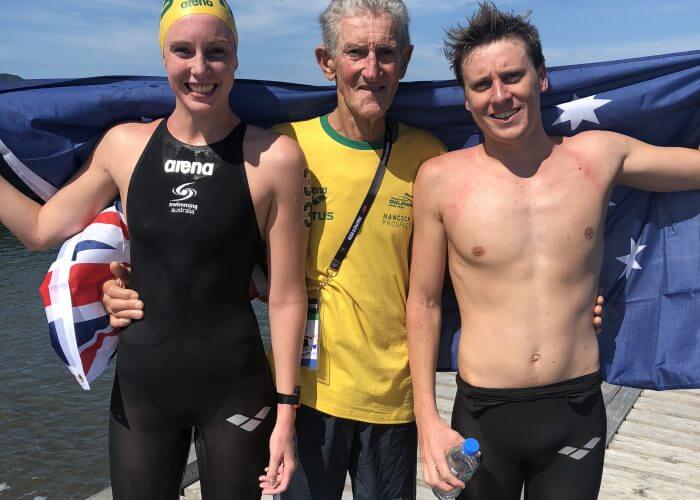
WHO’S IN THIS SHOT OF JR? Olympic qualifier Kareena Lee and Nick Sloman who is still in the hunt for 2021. Photo Courtesy: Hanson Media.
Wily coach John “JR” Rodgers, last week named the ASCTA Open Water Coach for the third time, was preparing to turn the clock back for Sloman. to the days when he put four-time Australian 1500m champion Maroubra’s Max Metzker on the 1976 and 1980 Olympic teams.
“I said Nick take your mind off being a 10km swimmer…you are now a pool swimmer and he looked at me…and I said Nick look at me..forget about the open water you are a pool swimmer and he had that mind set that he was going to swim the Trials and make the team in the 1500m,” said Rodgers, his 82-year-old coach, who had already placed Kareena Lee on the team for Tokyo.
“And then when the pandemic came and he had another chance I said Nick forget about the pool you are now back being an open water swimmer again.
“He’s a gun surfer and he is very good in the chop and his mind is now set back on the 10km…a 1500m swimmer capable of going sub 15 minutes…but the 10km…that’s he’s go.”
Rodgers is one of swimming’s great survivors and after six days in a coma following a sudden heart attack in July, he woke up to watch Kareena make the Olympic team.
JOHN RODGERS SURVIVES HEART SURGERY
KAREENA LEE DEDICATES OLYMPIC SELECTION TO COACH JR
SINGLE SHOT AT OLYMPIC DREAM
Australia, like so many other countries has just one spot available for a place in the men’s field after Lee secured her automatic nomination in the women’s field with a top 10 finish in the first selection round in last year’s Fina World Championships in Gwangju.
But only now have the ramifications surfaced, with National Federations having to go back to a revised selection criteria before the final fields for Tokyo can be determined.
FINA’s announcement this week confirming the Fukuoka Qualification Race postponement to May 29, 30, 2021 – with a maximum of two entrants from each country.
Federations now have to determine how they arrive at that point.
In some cases, like Australia, it will open the door for swimmers who had thought they had missed the Tokyo boat – their Olympic dreams shattered – but now actually given a second chance.
Last year’s Fina World Championships in Gwangju confirmed the first 10 men and 10 women to qualify for the now postponed Games and those quota positions will stand.
The 2021 Fukuoka qualifier will now determine the next nine places for each of the men’s and women’s fields with a further five regional places each to join the single spots open to the host country Japan – making up fields of 25 men and 25 women.
Here is the latest Fina selection revision with the list of qualifying athletes so far and details surrounding the 2021.
FINA SELECTION QUALIFICATION UPDATE
AUSTRALIA’S TOKYO PLANS A SHAW THING
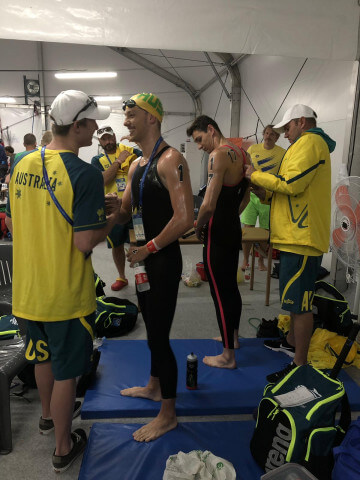
COMPETITIVE MATESHIP: Will this be the secret of Australia’s Open Water success. Photo Courtesy: Delly Carr, Swimming Australia.
Australia will now pin its Olympic open water plans for Toyko 2021 around “competitive mateship” with its four emerging Queensland boys forging ahead towards their Olympic dreams.
The isolation period has actually seen Armstrong training under Rodgers for six weeks, with his coach Sage on paternity leave after his wife gave birth to twins.
With no pool space open, Rodgers had set up his training base at Noosa Beach; Sage at Mooloolaba Beach and Edwards under Chris Nesbit’s TSS Aquatic’s champion distance and open water group at the Southport Spit and Tallebudgera Creek while Cotter under ASCTA Paralympic Program Coach of the Year Harley Connolly ( former assistant under Rodgers) swimming in the surf and on an ironman program out of the Maroochydore Surf Club.
(Cotter is also a dual international after representing Australia in Surf Lifesaving in South Africa this year).
Greg Shaw says his athletes and coaches are up for the challenge to get the best possible athlete ready for the Olympics.
“Our philosophy remains the same; to give the best athlete the best opportunity as we can within the Olympic selection processes and so re-setting that was the best option to maintain that philosophy and start afresh in January ‘21,” said Shaw.
“It remains important to select the best athlete at the time and as close to the Olympics as possible through that second round.
“We are in the process of finalising that selection process at the moment; we have the dates (and venue) set for the Australian Championships and will be making that announcement in a week or so.
“The processes will effectively be very similar. We will have to be flexible around the events we use; especially with travel restrictions but the philosophy remains to give the best athlete the best opportunity as we can within the Olympic selection processes and so re-setting that was the best option to maintain that philosophy…
“We would like to have that international race in Doha..we believe it is reflective of an international performance – a cornerstone of our process …..whether we can get out of the country or not we don’t know….
“But we also have to get our heads around the fact that international travel will be different from now on…and those changes might well restrict our international travel (and planning) considerably.
“We have to be purposeful with the events we choose and if possible Doha presents a really fantastic race for us.
“We see it as one of the most accessible high class races from an Open Water perspective; if we can maintain that in our selection criteria that would be optimal.
“But again I can’t guarantee that; we’re going to need to have some flexibility in our processes to be able to ensure we’ve got the best two swimmers from an international performance perspective on the line at the qualifier in Fukuoka.
“The one thing that has been obvious across this selection process is that we’ve got a bunch of boys capable of securing that spot and also going on to be competitive at the Olympics.
“They are all at an age and a trajectory; give them another year and they are all going to be different open water swimmers and again having seen how they have all gone about this isolation period all four boys particularly it’s going to be a good year for them.
“If they keep going on that trajectory we’re going to have a hard decision to make; it will be cut throat that race; it will be great for them and for the sport.
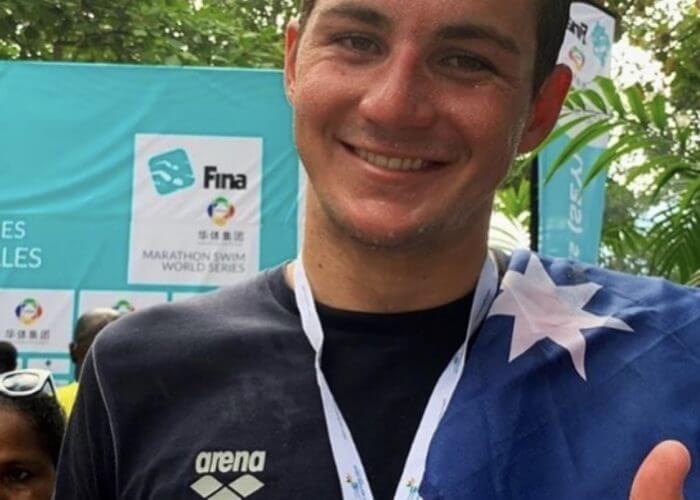
LUCKY STAR: Bailey Armstrong lives to fight another day. Photo Courtesy: Bailey Armstrong.
“Across the board in swimming in Australia the athletes have really found opportunities to keep moving and to be swimming and for Bailey Armstrong as an example in the situation that presented itself with JR was one of the really healthy things with our system.
“That group of boys get on pretty well together and also can see the value of training with each other challenging each other in that period of isolation which turned into an opportunity for Bailey. They were training in the same proximity, not together, but close by.
“ One of the things we have really tried is to foster ‘competitive mateship’ where you are competing against a mate and you know you can achieve better things together than you can in isolation.
“It’s been really good to see those boys and their personalities and their maturity develop over this period…
“The rest of 2020 will see a total internal focus for training and competition for Australia’s open water squads in and around every State.
“Domestically we will get in and train hard and have some fun in Australia.
“It is exciting to have four boys in close contention; I guarantee a lot of Nations would like to have that.
“Open Water in Australia is in a good position….Tokyo I’m sure will be a great meet for us and then on to Paris (2028) where we can really solidify from a potential perspective.”




Simon Neill